80. Walking in New York
A recent magazine section of the Sunday New York Times had as its theme “Walking New York” and included accounts by seventeen New Yorkers of walks in the city that for them had been especially significant. Concluding the accounts was a poem by Steve Duenes entitled “How to Walk in New York” that begins
Don’t text. Don’t smile. Don’t be injured. Don’t break stride. Don’t hum what’s in your headphones.
and finally concludes
Don’t be an obstacle. Don’t be sick. Don’t be old. Don’t stop. Don’t look back.
Mr. Duenes’s poem needn’t be taken literally. It would be well not to text when walking, but smiles and old age are permitted, and so are stops along the way. But other advice of his is quite appropriate, as for instance “Don’t talk on your phone” and “Don’t carry a giant umbrella” – two sins that walking New Yorkers often commit, causing peril to themselves and others.
Yes, as the Times article insists, in spite of all those vehicles that jam the streets, New York is a city of walkers. Walking is often the quickest way to get somewhere, given the slowness of ground transportation. Walking in congested Manhattan, I have often overtaken a crosstown bus stopped by a red light or a traffic jam, and when, resuming its trip, the bus overtakes me, often as not I will overtake it again and again. And if New Yorkers stride purposefully, intent on getting somewhere, in less pressured moments they also slow down to a stroll and enjoy the ever changing sights of the city.
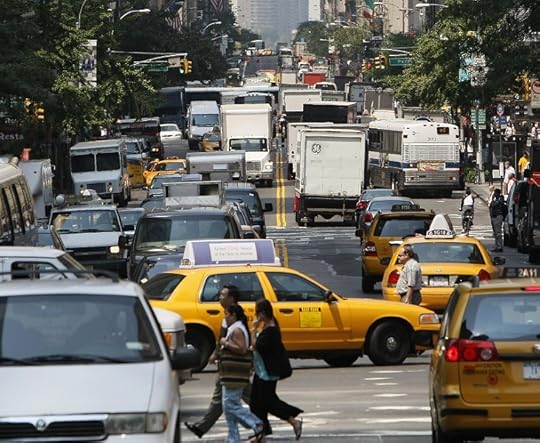 ILMRT
ILMRTI have always liked walking in the city, even undertaking long walks that few New Yorkers would want to invest the time and energy in, and I’ll recount a few those here, with the surprises they yielded. But I’ll start with a short recent walk from my West Village apartment to the new Whitney Museum of American Art in the Meatpacking District, a neighborhood in the northwest corner of the Village once characterized by huge carcasses of beef hacked up in messy packing plants. Typical of this ever-changing city, today the district has been utterly transformed by that insidious process known as gentrification. Which means bloody carcasses are out, trendy bars and restaurants are in, and especially “in” is the new museum. (For more on the gentrification of the Meatpacking District, see post #138, August 3, 2014.)
Going up Washington Street to Gansevoort, I found the museum there, cheek by jowl with the downtown (southern) end of the High Line, the elevated park that these days has become another “in” thing to do. More of that anon; for now, let’s have a look at the museum – the outside, that is, since I have yet to venture into it.
(Gansevoort Street: who or what was Gansevoort? I’ll do a post in the near future on the mystery and history of place names; the mystery of “Gansevoort” will be unraveled.)
The new Whitney, best seen from Gansevoort Street, looms impressively, the work of veteran museum architect Renzo Piano, one of the creators (or perpetrators) of the Pompidou Center in the Paris market district, a vibrantly modern edifice that wears its plumbing on the outside and strikes viewers as either a monster or a dazzlingly new creation. And the Whitney? Seen from the south or Gansevoort side, it looks like a stack of boxes piled on top of one another but not aligned. It looms, it juts, it overhangs. Whether you like it or not, you won’t forget it.
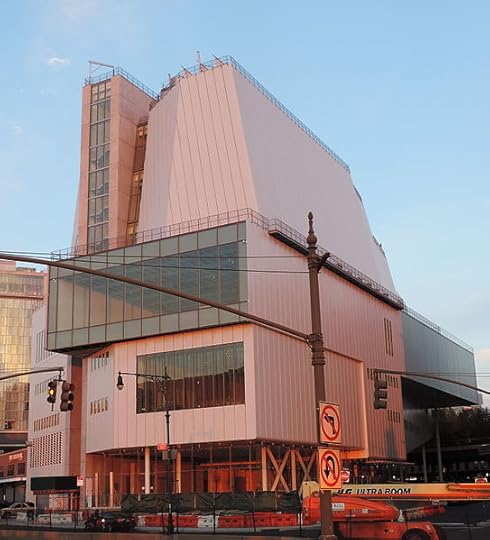 The Whitney, almost completed, in November 2014. Seen from the west -- the view
The Whitney, almost completed, in November 2014. Seen from the west -- the viewI couldn't get on foot.
Jim.henderson From the west or Hudson River side I couldn’t get a good impression of the museum, since the West Side Highway keeps you from getting a little distance away from it for a better view; a Times reporter describes the museum, when seen from that side, as vaguely nautical, perhaps a ship on blocks. Before trying for views from the east and north, I relaxed in a chair the museum generously provided on a little deck outside the glass-walled gift shop, which was crammed with visitors eager to buy books and souvenirs. Sitting with my back to the museum, I had a good view of both the highway, whose roar caressed my ears, and also, at the curb nearby, Call Ahead, an installation offering facilities to both sexes, except that it was shut up tight.
To see the museum’s exterior from the east and north, I mounted the stairs to the High Line (the elevator being “temporarily” closed), that narrow strip of green projected north from there one story above the city streets. There is no good view of the Whitney from the east, since the High Line obtrudes, but as you walk north along the High Line you can get a view of the north or uptown face of the museum, which the Times reporter describes as resembling a factory or hospital, with a wall of windows and a cluster of protruding pipes. To my eye it looks like two boxes: a big box on the right rising sheer and clunky, and next to it a lower box on the left with protruding spikes and, far above this box, several tiers of catwalks thronged with visitors.
All in all I would call the Whitney an assemblage of masses, an oddity not meant to soothe the psyche, but jolt it. Original it certainly is, but for many – like the Pompidou, or even at one time the Eiffel Tower, in Paris – it may take some getting-used-to. As one French paper said of the Pompidou, “love at second sight.” The adventure of the interior still awaits me, but those catwalks a-crawl with visitors make me just a bit nervous, as do the glass walls and plunging perspectives of the new MOMA (Museum of Modern Art).
I harbor no mixed feelings about the High Line, that strip of greenery built along what was once an elevated spur of the New York Central Railroad; the park is a sheer delight. As I strolled a short distance north, I encountered a grove of birch trees planted along the abandoned railroad tracks, and also, side by side, a dogwood and a redbud, both in bloom. There were visitors everywhere snapping photos of each other and the greenery, or lining up at snack bars, or stretched out on benches and soaking up the sun. The walkway passes under several soaring modern buildings whose huge windows offer views of the High Line and add to the super-modern and trendy new look of the Meatpacking District, though the High Line cannot escape the whining and grinding noises, horn blasts, and siren wails rising from the street. Still, it’s an inspiration, a wonder.
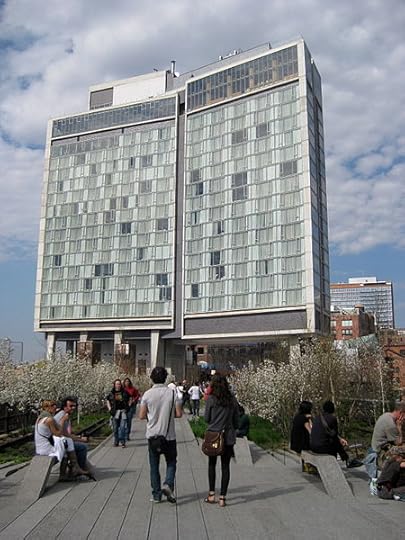 The High Line, passing under the Standard Hotel.
The High Line, passing under the Standard Hotel.La Citta Vita
Every walk offers surprises. Leaving the High Line at 14thStreet, I walked south along Washington Street and realized that the area is still a work in progress: on the left or east side of the street, trendy shops; on the west side, distracting construction noises and meatpackers’ trucks parked at loading platforms – proof that the Meatpacking District still, to some extent, lives up to its name. And then, as I walked along Horatio Street toward Greenwich – a walk I had never done before – I discovered a row of Greek Revival houses on the north side of the street: either well-kept homes from the nineteenth century, or inspired replicas. Doubt as to their genuineness vanished when I spied, on numbers 11 and 13, plaques reading “1836,” the date of their construction. So it is in the Village, as in other old sections of the city: charming Federal and Greek revival houses and brownstones, well preserved, where you least expect them. The rage of modernity has not reached – or shall I say infected – all the city.
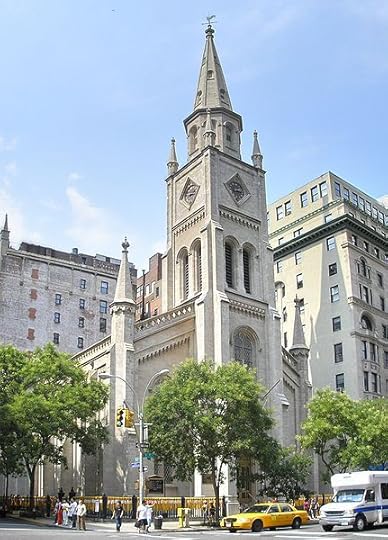 Another walk I used to do took me from the Public Library at Fifth Avenue and 42nd Street down Fifth to the Village. I was usually doing research in the library and chose to walk home around 5 p.m. to stretch my legs and avoid the crowds in the subway. For me this was a familiar walk, but two surprises awaited me. First, at Fifth Avenue and 29thStreet I passed the Marble Collegiate Church, an impressive marble structure built in 1854 in what is designated Neo-Romanesque Gothic style with a soaring steeple. And there, posted on the building, was the name of its pastor: Dr. Norman Vincent Peale. I had no idea that the renowned author of The Power of Positive Thinking, a 1952 best seller selling in the millions, was the minister of a church right here in Manhattan. No, I wasn’t tempted to attend services or read the book, but for years I looked for his name on the church. Then, one day in 1984, I discovered a different name there and realized that the famous Dr. Peale had retired. Another surprise, and a reminder that nothing lasts forever, not even the author of The Power of Positive Thinking. Dr. Peale died in 1993, but his presence still inspires the church in the form of a life-sized bronze statue installed in the churchyard in 1998. (For more on Dr. Peale, see post #149, where he appears in the company of Fulton J. Sheen, that other rock star of devotion.)
Another walk I used to do took me from the Public Library at Fifth Avenue and 42nd Street down Fifth to the Village. I was usually doing research in the library and chose to walk home around 5 p.m. to stretch my legs and avoid the crowds in the subway. For me this was a familiar walk, but two surprises awaited me. First, at Fifth Avenue and 29thStreet I passed the Marble Collegiate Church, an impressive marble structure built in 1854 in what is designated Neo-Romanesque Gothic style with a soaring steeple. And there, posted on the building, was the name of its pastor: Dr. Norman Vincent Peale. I had no idea that the renowned author of The Power of Positive Thinking, a 1952 best seller selling in the millions, was the minister of a church right here in Manhattan. No, I wasn’t tempted to attend services or read the book, but for years I looked for his name on the church. Then, one day in 1984, I discovered a different name there and realized that the famous Dr. Peale had retired. Another surprise, and a reminder that nothing lasts forever, not even the author of The Power of Positive Thinking. Dr. Peale died in 1993, but his presence still inspires the church in the form of a life-sized bronze statue installed in the churchyard in 1998. (For more on Dr. Peale, see post #149, where he appears in the company of Fulton J. Sheen, that other rock star of devotion.)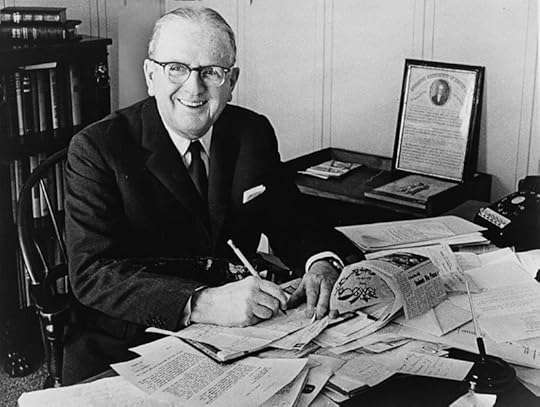 Dr. Peale in 1966, looking fatherly and benign. And what a smile!
Dr. Peale in 1966, looking fatherly and benign. And what a smile!And the second surprise on my walk downtown on Fifth Avenue? Minnie Mouse. Yes, there she was on the sidewalk, along with other beloved Disney characters and related species, welcoming buyers flocking to some event on the Avenue just above 23rdStreet and across from Madison Square. I never quite grasped what the occasion was, but the arriving visitors must have been buyers from out-of-town stores coming to New York in July – and a hot July at that – to place orders for goods to be sold during the Christmas holiday season. It’s a hardship of the profession that buyers have to guess, months in advance and in the heat of summer, what will sell at the chilly onset of winter, but Minnie and her cohorts were there to make their decisions easier. Maybe it was a toy fair for wholesalers, one of those annual events open only to the trade. But it was a fun moment for me, and a surprise, to see Minnie and her friends in action, though I didn’t envy the humans sweating inside those costumes in July.
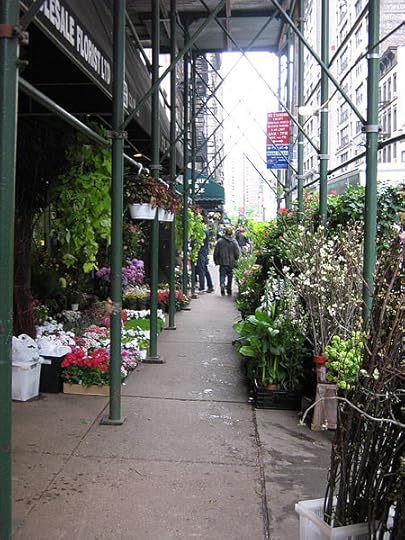 dave_7 Another trip took me uptown from the Village to do research in the library (what a scholar I must have been in those days!), and then on farther uptown to the Whole Foods Project lunch in a church on West 73rd Street. En route I often found myself in the midst of the Flower District, which today runs along West 28th Street between Sixth and Seventh Avenues, an amazing jungle of greenery where plant wholesalers and retailers set plants out on the sidewalk: tubs of flowers, shrubs, even orange trees and palms, sometimes so thick and tall a growth that you almost forget you’re in a city. And there’s more inside the shops, whose shelves are crammed with every kind of plant conceivable, and pots and vases and gardening tools, and even imitation fruits that from a distance can’t be told from the genuine article. But this is a place to buy in bulk – for a wedding, for example – since the flowers and plants are sold in bunches, but it’s also a place to buy cheap.
dave_7 Another trip took me uptown from the Village to do research in the library (what a scholar I must have been in those days!), and then on farther uptown to the Whole Foods Project lunch in a church on West 73rd Street. En route I often found myself in the midst of the Flower District, which today runs along West 28th Street between Sixth and Seventh Avenues, an amazing jungle of greenery where plant wholesalers and retailers set plants out on the sidewalk: tubs of flowers, shrubs, even orange trees and palms, sometimes so thick and tall a growth that you almost forget you’re in a city. And there’s more inside the shops, whose shelves are crammed with every kind of plant conceivable, and pots and vases and gardening tools, and even imitation fruits that from a distance can’t be told from the genuine article. But this is a place to buy in bulk – for a wedding, for example – since the flowers and plants are sold in bunches, but it’s also a place to buy cheap.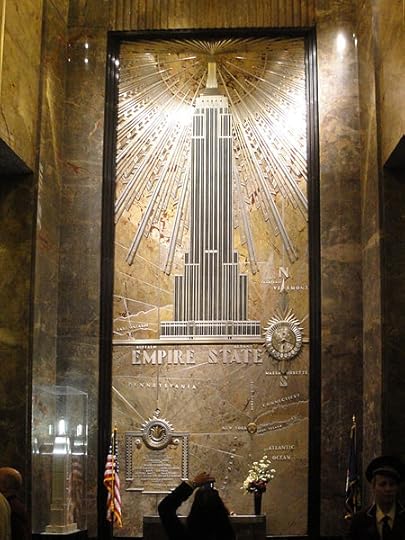 The lobby mural of the Empire State Building.
The lobby mural of the Empire State Building.OptimumPx Once past that special district, the greenery disappears and the reality of city life – the crowds, the noise, the congestion – presses hard upon you. But usually I would approach the Empire State Building along 33rd Street, enter it (this was before 9/11), and walk the lobby’s dim but spacious corridors past an aluminum relief of the skyscraper, and exit at the Fifth Avenue entrance to continue up the avenue to the library. Just walking through that building gave me a special, indefinable thrill.
Later, leaving the library after a bit of research, I would enter an arcade that took me from 42nd to 43rdStreet, and then another arcade from 43rd to 44th Street, coming out on 44th near the renowned Algonquin Hotel, where writer and critic Dorothy Parker and her accomplices once convened for the famous Algonquin Round Table to trade opinions and gossip and mordant wit. (For more of that renowned but bitchy clique, see post #166, February 11, 2015.) From there I would proceed up one of the avenues to Central Park, and then up Broadway past Lincoln Center – not at its best in broad daylight – to my destination on 73rd Street. And after that longish trek, did I have an appetite for lunch!
Another walk took me from the Village to the lighting and lamp district on the Bowery. Needing a lamp for the living room, I decided to walk to the Bowery and in the process discovered – or rediscovered -- one district after another in this endlessly diverse city. Crossing Houston Street, I entered Soho (or SoHo), a trendy district south of Houston now known for artists’ lofts, galleries, and boutiques, but once a neighborhood of commercial buildings with cast-iron façades housing small factories, sweatshops, warehouses, and printing plants. By the 1960s these operations had moved out, and artists began moving into the abandoned buildings offering low-rent lofts with large spaces, high ceilings, and big windows admitting natural light. Then, by the 1980s, gentrification set in like a creeping disease – or a marvelous enhancement, if you like – following which the neighborhood became “hip” and “in” and high-priced, and a mecca for tourists.
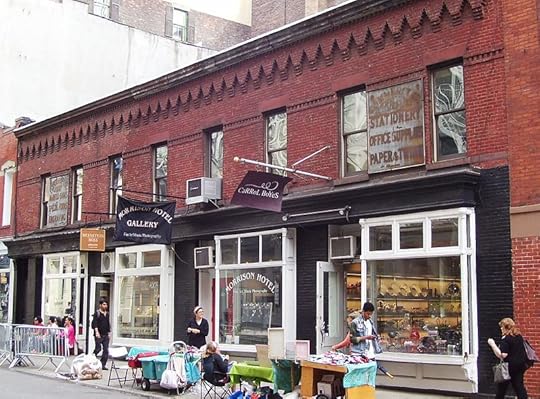 120-126 Prince Street in Soho, two buildings with a common façade made of brick, stone, and iron. Built in 1892-93 for stores and light manufacturing, on the ground floor they now house trendy
120-126 Prince Street in Soho, two buildings with a common façade made of brick, stone, and iron. Built in 1892-93 for stores and light manufacturing, on the ground floor they now house trendy shops and a gallery.
Beyond My Ken
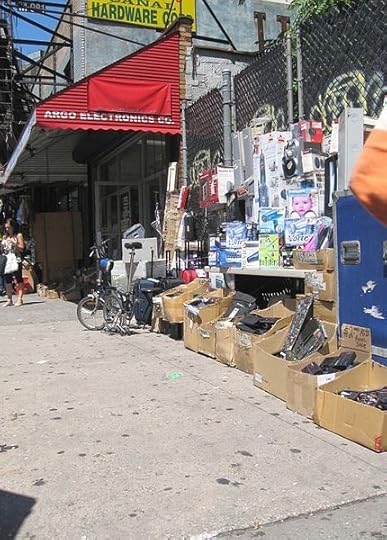 One of the last Radio Row stores on Canal Street. Crossing Canal Street, I left Soho behind and skirted Little Italy, now a shrunken remnant of its former self, its presence announced here by a handful of Italian restaurants. (Many Italians moved out long ago to Brooklyn, Staten Island, and the fair suburban pastures of New Jersey and Long Island – another familiar pattern in the city, as immigrants prospered and crept into the ranks of the middle class.) By now I was close to my destination, with signs in Chinese announcing Chinatown’s expansion northward across Canal Street, and nearby, on the north side of Canal Street, the remnants of Radio Row, a stretch of the street once lined with radio and electronics stores. And at Canal Street and the Bowery I also encountered the Downtown Diamond District, from which merchants once migrated to create the better-known Uptown Diamond District on 47th Street between Fifth and Sixth Avenues.
One of the last Radio Row stores on Canal Street. Crossing Canal Street, I left Soho behind and skirted Little Italy, now a shrunken remnant of its former self, its presence announced here by a handful of Italian restaurants. (Many Italians moved out long ago to Brooklyn, Staten Island, and the fair suburban pastures of New Jersey and Long Island – another familiar pattern in the city, as immigrants prospered and crept into the ranks of the middle class.) By now I was close to my destination, with signs in Chinese announcing Chinatown’s expansion northward across Canal Street, and nearby, on the north side of Canal Street, the remnants of Radio Row, a stretch of the street once lined with radio and electronics stores. And at Canal Street and the Bowery I also encountered the Downtown Diamond District, from which merchants once migrated to create the better-known Uptown Diamond District on 47th Street between Fifth and Sixth Avenues. But I wasn’t looking for diamonds or a radio or a Chinese meal, I wanted a lamp. So I turned north on the Bowery and discovered shops selling lamps and lighting fixtures on both sides of the street between Grand and Broome Streets. Any kind of lighting fixture you might desire is available in these shops, their wares displayed in bewildering profusion. Fortunately, I found just the lamp I needed in the very first shop I entered, though I checked out several others before returning to buy that lamp. But this district too, a shadow of its former self, is in danger, thanks in part to – you guessed it -- gentrification. Even the Bowery – once the city’s notorious skid row – is getting trendy and upscale, so higher rents and the rise of online shopping are causing the lighting stores to close. As for the flophouses that once characterized the street, there are very few left. Also threatened is another nearby district, the wholesale restaurant- and bar-supply district along the Bowery just south of Houston. (For more on the Bowery, see post #90, "The Bowery: From Bhoys to Bums to Condos," October 2, 2013.)
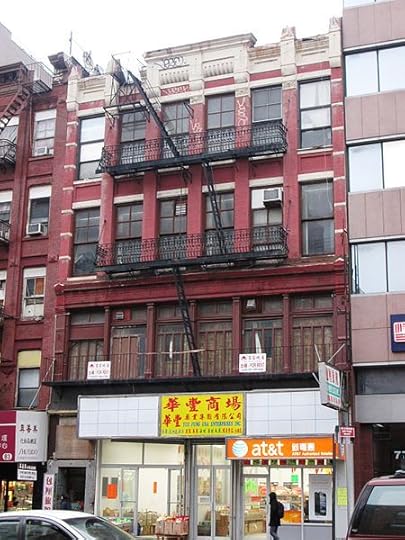 The Bowery Lodge at 81 Bowery, one of the last skid row flophouses. The signs
The Bowery Lodge at 81 Bowery, one of the last skid row flophouses. The signsin Chinese show how Chinatown has spread north of Canal Street.
Beyond My Ken Soho, Little Italy, Chinatown, Radio Row, the Downtown Diamond District, the Lighting District, and the restaurant- and bar-supply stores just to the north – not a bad succession of sights in the course of a twenty- or thirty-minute walk in Manhattan. Only on foot can you savor the rich mix of the city, register its endless succession of surprises.
Sometimes the city surprises you during a walk that you have done a hundred times or more. Though I have often visited Union Square and its greenmarket, only recently did I notice an impressive building on the northeast corner of East 15th Street and Union Square East, a high building fronted by four soaring Corinthian columns that made it look like a bank of another time. Going closer, I read the words FUERZA BRUTA in big letters above the columns. “Fuerza bruta”? “Brute force”? What was this all about? Going closer still, I saw a sign announcing the Daryl Roth Theatre, a theater I had never heard of. So was this a movie theater offering a Spanish-language film to Latinos? A theater that looked like a bank that looked like an ancient Greek temple?
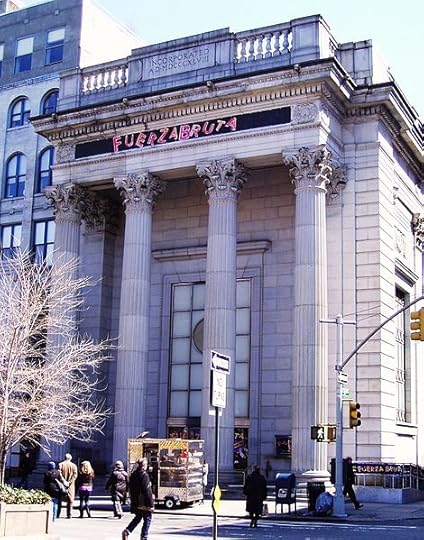 Beyond My Ken
Beyond My KenBy the time I got home, I had forgotten the name of the theater, but “fuerza bruta” stuck in my mind, and the Internet, that vast repository of useful and useless facts, led to me the theater and finally to the building’s history. Fuerza Bruta – translated as “Brute Force Wind” (though where they got the “wind” I’ll never know) – is advertised as a “hit off-Broadway interactive experience” that has returned to New York with WAYRA, a new show that will “flood your senses with heart-thrashing fun, pulse-pumping live music and breathtaking aerial acrobatics.” Which makes it sound like a multimedia event combining jazz, circus, and I’m not sure what – “environmental eye candy,” as one reviewer put it. Just reading about it wore me out, but I’m sure it finds its audience … somewhere.
But this is irrelevant; my interest is in the building itself. Completed in 1907 as the new home of the Union Square Savings Bank, it had (and still has) a façade of white granite whose classic Greek temple style was meant to convey, to a public still unnerved by the financial crisis of 1893, an impression of order and sobriety -- in other words, a safe place to deposit your goodies. (Bad timing: in that same year 1907 there was another financial panic, and a bad one.) As for the spacious interior, it was outfitted in marble and bronze and lit by stained-glass skylights far above, while depositors could tread on black-and-white mosaic tiles made of (of all things!) rubber.
The bank survived various panics, including the Great Crash of 1929 and the lean years that followed, and underwent a merger and a name change, before being acquired by the American Savings Bank in 1982. Under this rubric it entered into a series of bad real estate loans, foundered, and was closed by state regulators in 1992.
What becomes of an elegant Greek-temple-like bank, after it ceases to be a bank? It sat empty for several years and then in 1996 was acquired by award-winning theater producer Daryl Roth, who converted it into a theater modestly named for herself. But that same year the building became a New York City landmark, so the monumental exterior remains intact, no matter what wild happenings are raging inside. How I could have overlooked the building all these years, I will never understand. In my opinion, it is the handsomest, and architecturally the most interesting, structure facing Union Square.
A mystery surge: Last Tuesday, May 12, coinciding with a surge in bug activity in my apartment (I slaughtered dozens), there was a surge in page views of this blog. Normally there are between 80 and 150 views a day, and if, rarely, the number rises to near or slightly above 200, I’m surprised and delighted. But last Tuesday the number surged mysteriously near noon, and the final total for the day was 336 – an unprecedented figure. Why? I have no idea. An invasion of foreign hackers? No, most of the views were – as usual – from this country. And of course the day’s total on Wednesday sank back to normal. Hopefully, the number of bugs will likewise diminish, though I’m not counting on it. And which posts got the most hits? The top five:
1. #89, Who Really Runs America? David Rockefeller?2. #179, The West Village Then and Now (the most recent post)3. #43, Man/Boy Love: The Great Taboo (usually gets the most)4. #141, Hell House and Christian Terrorism5. #136, Francis J. Spellman, the Controversial Cardinal (another perennial favorite, posing the inevitable question: Was he or wasn’t he?)
Clearly, favorite topics are sex, politics, and (as long as it’s not bland) religion.
Banks: Viewers of this blog know how I love banks – the big ones, that is. Goodness gracious, five of the biggest – Barclay’s, Citigroup, the Royal Bank of Scotland, UBS, and my own dear J.P. Morgan Chase – are reportedly about to plead guilty to felony charges brought by the U.S. Justice Department. The banks are accused of rigging the price of foreign currencies and will pay billions in fines. But surely no one will go to prison, since that might upset the whole financial world unduly. Coming soon: Nonprofits and What They’re Up To: Cemeteries, Old Houses, Pianos, Pennies, and the Gowanus Canal.
© 2015 Clifford Browder
Published on May 17, 2015 05:29
No comments have been added yet.



